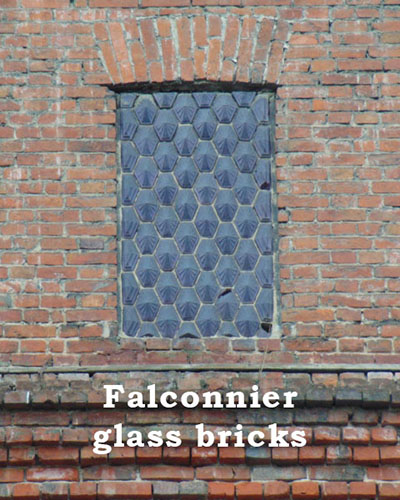- Maly Kharitonyevsky Lane 4
-
55.76704, 37.643517 (OpenStreetMap, Google Maps, Yandex Maps)
- Northwest wall of the building
- Number of windows made of Falconnier glass bricks (see image)
-
Историческая справка
The Moscow Polytechnic Society was founded in 1878 by alumni of the Imperial Moscow Technical School, now Bauman Moscow State Technical University. The emblem of the society - "ПО" - still decorates the main façade of the building, and the date of its foundation is etched on the left of the main oriel window. On the right, there is the year 1905 when the cornerstone of the building was laid.


The house was built in the style of English Gothic. Its architect Alexander Kuznetsov explained later: "For the façade design, the architectural motives of England are adopted, as it is England which has given us the first steam engine, the first steam locomotive, the first steamboat, and the first loom."
Windows made of Falconnier bricks can still be found on the blank firewalls of the building.
In the late 1880s, the Swiss engineer Gustave Falconnier invented a novel type of glass building block or "glass brick". Falconnier bricks were blown in a mold like bottles, but had the original feature of being sealed air-tight with a pastille of molten glass while hot; after cooling, the hot air trapped inside contracts, forming a partial vacuum. Their sides were recessed to take mortar and were laid up like ordinary masonry bricks, with or without embedded metal reinforcing. Falconnier bricks were touted for not tarnishing, trapping dust, or retaining water.
Falconnier bricks were highly regarded; they were produced in France, Germany, Belgium, England and the USA. In Russia, glass bricks were made at Tsarevshchinsky Glass and Crystal Plant (the village of Khvatovka, Saratov Region), Uspensky Glass Plant of the Vladimir Governorate, and in St. Petersburg, on Vasilyevsky Island by "M. Frank and Co." Glass Plant.
Glass bricks became widely used in apartment and industrial buildings of Moscow and St. Petersburg in the late 19th and the early 20th centuries. They were usually adopted to illuminate back staircases.
Falconnier bricks are rare today and existing installations even rarer. Like all glass bricks, including modern ones, they can't be replaced once damaged, so old installations often have unsightly patches.
Входил в трассы категорий Лев & Единорог
Статистика взятия: 72/73 (99%).
По категориям:
- Лев & Единорог: 72/73 (99%)




